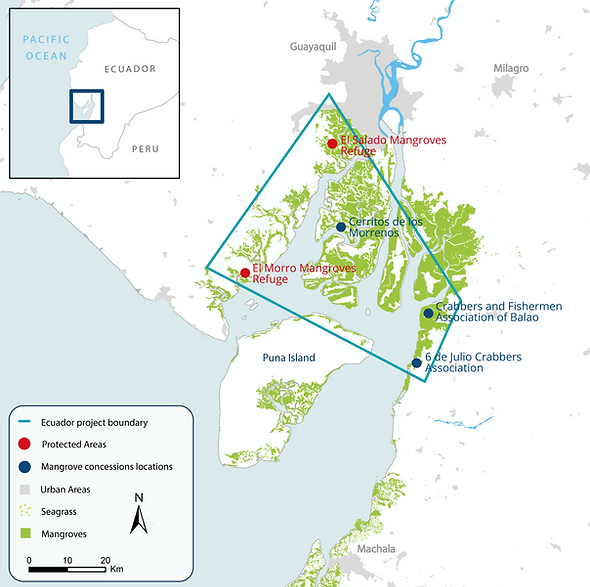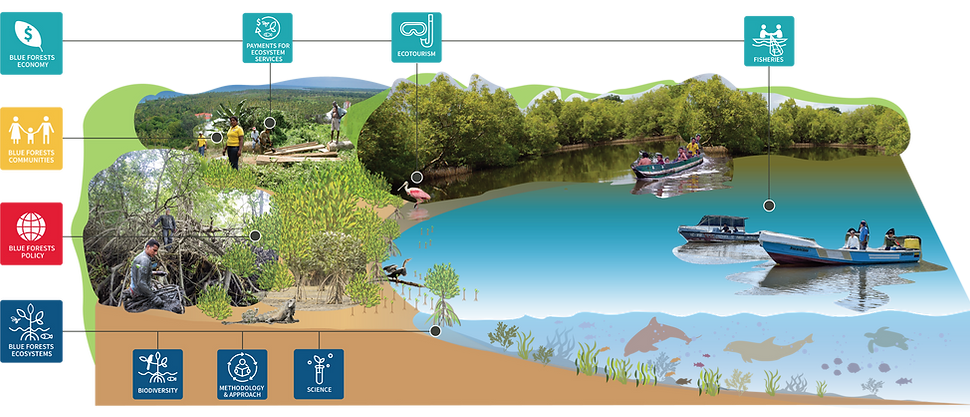Mangrove forests, seagrass meadows, saltwater marshes – these and other ‘blue forests’ are vital to coastal and island communities around the world
Located in the Gulf of Guayaquil in southern Ecuador, Blue Forests Project partnered with Conservation International (CI), an international non-profit organization with a presence in Ecuador since 2001.
The project aims to facilitate a sustainable, long-term mangrove conservation agreement program to conserve the mangroves and protect them from degradation. Community associations make an important contribution to poverty alleviation and biodiversity conservation in the area.
CI in Ecuador focused on mainstreaming information about mangrove ecosystem services into national policy frameworks and developing useful concepts, language and tools for policymakers to take actions on sustainable mangrove conservation and restoration.
This page is an overview of the Gulf of Guayaquil Blue Forests Project. For an in-depth version of the Ecuador case study, click here.
Ecuador
Ecuador
Ecuador


Aerial Views Ecuador Shrimp Ponds

Biodiversity of the Ecuador site

Aerial Mangroves of Ecaudor

Village Life Ecuador
Mangrove ecosystems are important to communities throughout coastal Ecuador. Current uses include crab and shellfish collection, and fisheries. In recent history, mangrove ecosystems in Ecuador were impacted by aquaculture (shrimp farms) and urban expansion. However, recent laws have raised the status of protection for mangroves. Approximately one third of existing mangroves in Ecuador are managed by conservation agreements with local communities.
When mangroves are conserved the the well-being of fishermen is achieved through increased income and opportunity from robust and sustainable fisheries. Mechanisms like conservation agreements allow people to access goods and services that materialize into better living conditions and more sustainable livelihoods.
CI Ecuador worked across scales, from informing and collaborating with the national government in support and implementation of current policy to directly on the ground with local fishing associations to provide direct benefit to communities dependent on healthy mangroves. CI worked to identify bottlenecks for implementation and increase awareness to reduce these barriers to participation in these programs. These policies are funded and created at the national level but have direct impact on local communities.
Outreach and support were given to communities to facilitate the creation of fishing associations, including assistance with documentation and paperwork such as invoicing and agreements. Support to increase the access and resiliency to the market was increased through better distribution networks.
Gulf of Guayaquil
CI has worked closely with the Minister of the Environment, coastal managers, and directly on the ground with eight fishing associations to protect the mangrove areas within the five sites in the Gulf of Guayaquil. The Gulf of Guayaquil is the largest estuary in the country and is recognized as the most important estuary on the coast of South America due to the contribution of many environmental goods and services including shoreline protection, fishery habitat, pollution filtering and habitat that supports biodiversity.
To address the loss of mangroves and promote conservation, the Ecuadorian government developed a 4-phase mangrove protection plan that sets aside conservation areas covering 159,000 hectares (ha) of mangroves. CI, in partnership with the Ministry of the Environment and Water, collaborated on the design and implementation of the Socio Manglar program. This program focused on conserving 41,000 ha within the Gulf while providing direct economic incentives to the local communities that commit to support the conservation program.

Facts at a Glance
Ecosystem Benefits
-
67,460 hectares of mangroves protected
Community Benefits
-
21,234 livelihoods supported through community conservation agreement


Project Location

What are the key pathways
to reach these goals?

What are the goals of the
Ecuador Blue Forests project?

What are the benefits and impacts of
this blue forests initiative?
The Gulf of Guayaquil is known for its dolphins, frigate birds and mangrove crabs. CI Ecuador's project supports sustainable livelihoods and long term management of mangroves. Click on each pathway icon to learn more.


















